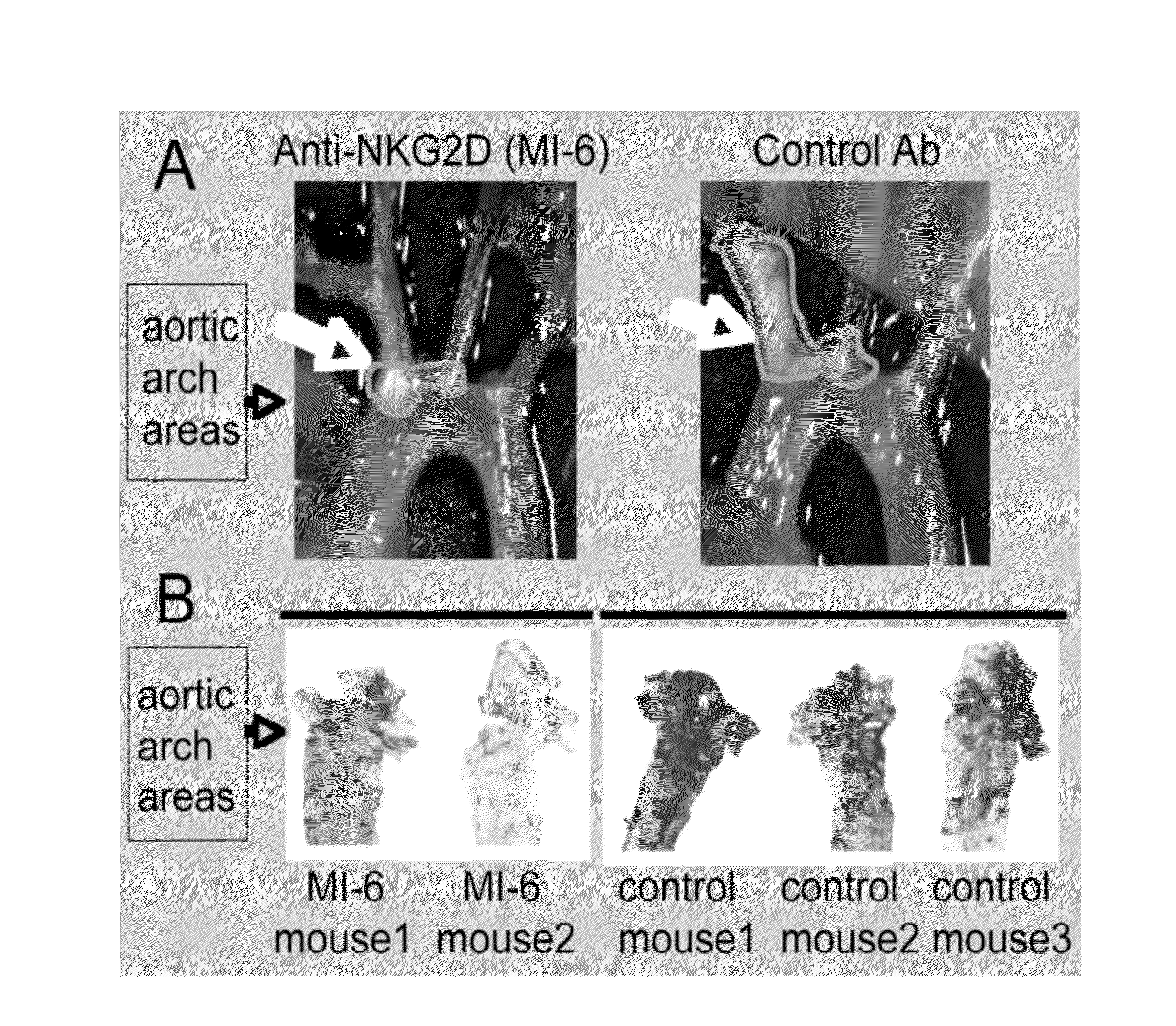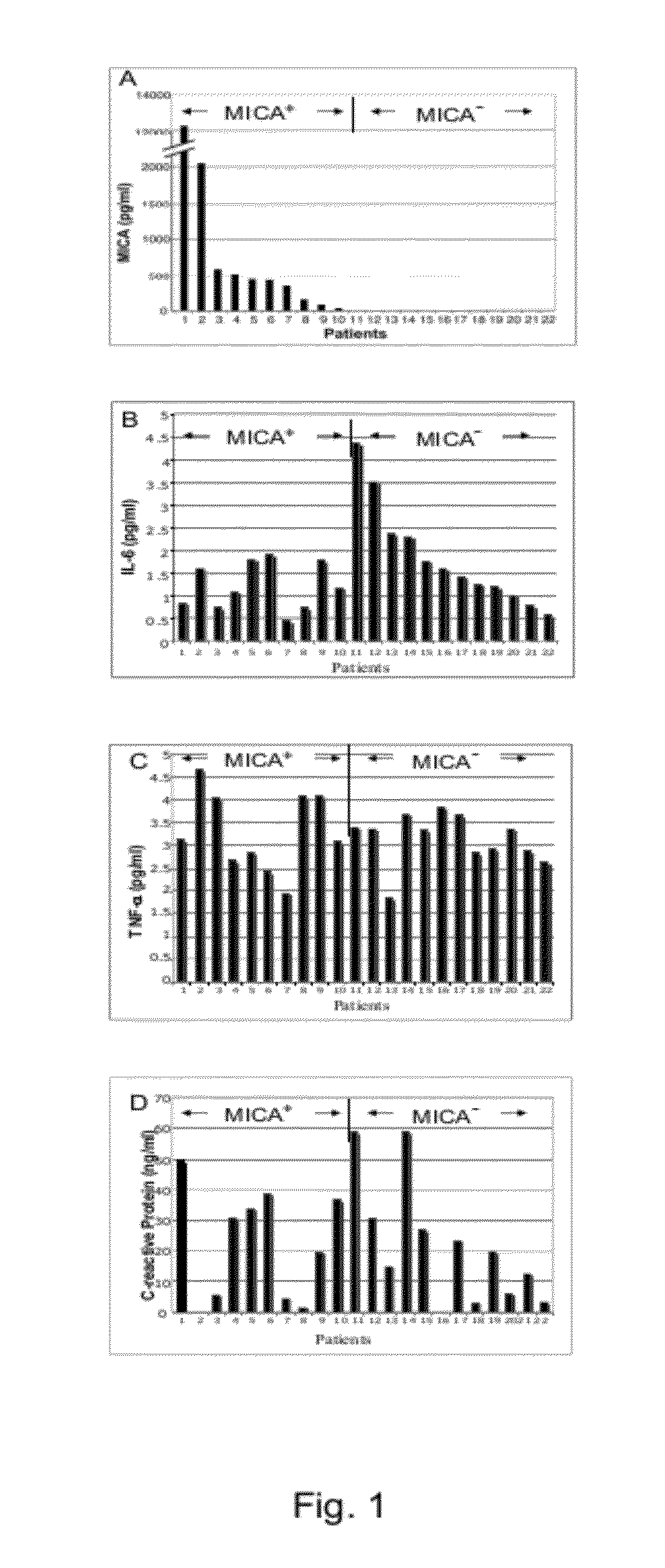Use of nkg2d inhibitors for treating cardiovascular and metabolic diseases, such as type 2 diabetes
a technology of nkg2d inhibitors and inhibitors, which is applied in the direction of extracellular fluid disorder, antibody medical ingredients, metabolic disorders, etc., can solve the problems of increased risk of heart attack, total loss of beta cells and endogenous insulin secretion, and progressive loss of pancreatic beta cells, so as to improve glucose tolerance, reduce blood glucose levels, and reduce insulin resistance
- Summary
- Abstract
- Description
- Claims
- Application Information
AI Technical Summary
Benefits of technology
Problems solved by technology
Method used
Image
Examples
example 1
Detection of MICA, a Ligand for NKG2D, in Sera and Atherosclerotic Plaques of Type 2 Diabetes Patients and its Association with Expression of Other Proinflammatory Cytokines
[0146]To determine whether metabolic dysfunction might cause upregulation of certain stress response immune stimulating molecules, MICA / B expression was assessed in a group of type 2 diabetic patients who have confirmed diabetes and, in some, have dyslipidemia as well. Type 1 diabetic patients were not included because they are mostly of autoimmune diseases and might have MICA upregulation independent of the metabolic conditions, as inferred from type 1 diabetic NOD mouse studies (Ogasawara et al., Immunity, 20:757-767 (2004)). Since it is unpractical to analyze MICA / B expression on blood vessels of the patients, levels of soluble MICA (sMICA) proteins in the blood were assayed. The sMICA is enzymatically cleaved products of membrane MICA (mMICA) expressed on the cell surface and was previously reported to be det...
example 2
Upregulation of NKG2D Ligands in Cells of Atherosclerotic Plaques and Other Tissues of ApoE− / − Mice
[0152]To test directly whether the ligands for NKG2D were upregulated in blood vessels of diabetic and dyslipidemic mice, expression of NKG2D ligands was determined in ApoE− / − mice, an animal model of dyslipidemia and atherosclerosis. It has been well established that the chronic dysfunctional metabolism in the ApoE− / − mice leads to the development of atherosclerotic plaques, in which immune cells account for a significant portion. These mice have impaired lipid metabolism and develop atherosclerosis as they age. The upregulation of NKG2D ligands in aortae of ApoE-null mice that developed atherosclerotic plaques was analyzed.
[0153]First, mRNA expression of the NKG2D ligands was examined in aortae of 8-10 month-old ApoE− / − mice (no diabetic induction) which had atherosclerotic plaques in the aorta, especially in the arch areas. Referring to FIG. 3A, to determine specifically whether the...
example 3
Suppression of Plague Formation in ApoE-Null Mice by Blockage of the NKG2D / Ligand Interaction with Monoclonal Anti-NKG2D Antibodies or NKG2D Knockout
[0159]The NKG2D ligand upregulation in arteries, especially on the plaques, might activate NKG2D-expressing immune cells to promote the vascular inflammation and atherosclerosis. To test this, monoclonal anti-NKG2D antibody (clone MI-6) was injected into diabetic ApoE-null mice to block the potential NKG2D / ligands interaction and whether such a blockage could suppress the plaque formation was determined. Injection of the anti-NKG2D antibody has been shown to block the NKG2D / ligand interaction in mice without deleting NKG2D-expressing immune cells (Jamieson and Raulet, unpublished). Six-week old male homozygous ApoE-null mice of C57BL / 6 background were induced diabetic by STZ injection to accelerate the plaque formation. One week and three days before the STZ administration, 200 micrograms / injection of the monoclonal anti-NKG2D antibody ...
PUM
| Property | Measurement | Unit |
|---|---|---|
| concentration | aaaaa | aaaaa |
| volume | aaaaa | aaaaa |
| insulin resistance | aaaaa | aaaaa |
Abstract
Description
Claims
Application Information
 Login to View More
Login to View More - R&D
- Intellectual Property
- Life Sciences
- Materials
- Tech Scout
- Unparalleled Data Quality
- Higher Quality Content
- 60% Fewer Hallucinations
Browse by: Latest US Patents, China's latest patents, Technical Efficacy Thesaurus, Application Domain, Technology Topic, Popular Technical Reports.
© 2025 PatSnap. All rights reserved.Legal|Privacy policy|Modern Slavery Act Transparency Statement|Sitemap|About US| Contact US: help@patsnap.com



